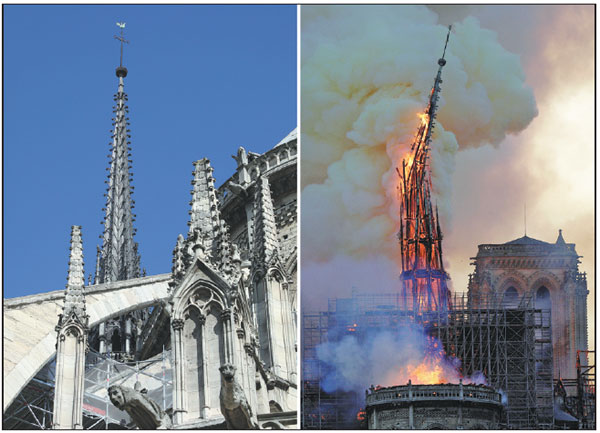Notre Dame hailed as a great monument to 'best of civilization'
NEW YORK - Notre Dame, a survivor of wars and revolutions, has stood for centuries as not merely the greatest of the Gothic cathedrals and a towering jewel of Western architecture.
It has stood, in the words of one shell-shocked art expert, as "one of the great monuments to the best of civilization".
And so it was that across the globe on Monday, a stunned and helpless art world wept alongside the people of France as a massive fire ravaged the beloved cathedral.
|
This combination photo shows the landmark steeple of Notre Dame Cathedral before (left) and after Monday's devastating fire. Agence France-Presse |
"Civilization is just so fragile," said Barbara Drake Boehm, senior curator at the Metropolitan Museum of Art's medieval Cloisters branch in New York, her voice shaking as she tried to put into words what the cathedral meant. "This great hulking monument of stone has been there since 1163. It's come through so many trials."
"It's not one relic, not one piece of glass - it's the totality," she said, struggling to find words expansive enough to describe the cathedral's significance. "It's the very soul of Paris, but it's not just for French people. For all humanity, it's one of the great monuments to the best of civilization."
Construction on Notre Dame - French for "Our Lady" - began in the 12th century and continued for nearly 200 years. It sustained damage and fell into neglect during the French Revolution, but received renewed attention following the 1831 publication of Victor Hugo's novel The Hunchback of Notre-Dame. This led to two decades of restorations, including the cathedral's famous flying buttresses and a reconstructed spire.
While most kings were crowned elsewhere, Napoleon Bonaparte made sure he was crowned there in 1804, and married there in 1810.
Experts note that Notre Dame is an aesthetically smooth synthesis of different centuries. "It all blends together so harmoniously," said Nancy Wu, a medieval architecture expert and educator at the Met Cloisters. She said she was struck by delicacy of the structure, as well as the three stunning stained-glass rose windows, and the elegant exterior carvings.
"There are a lot of details that remind one of intricate lace," she said, "even though it's a building of cold hard stone".
Aside from the structure, art experts were concerned about the fate of countless priceless artworks and artifacts inside, including relics like the crown of thorns, which is only occasionally displayed. Paris Mayor Anne Hidalgo later said on Twitter that the crown of thorns and the tunic of St. Louis were among the artifacts saved.
"This cathedral has a number of elements that are not just famous but religiously significant," said Julio Bermudez, professor at the school of architecture and planning at Catholic University in Washington, "One of course is the crown of thorns ... the faithful believe this is the crown that the Savior put on his head. It's kept in a very safe place. But you know the fire is tremendously damaging." He also expressed concern about the beautiful stained-glass windows, which he called "really irreplaceable".
Boehm, at the Cloisters, found herself thinking about how the cathedral is at once of the past, and of the present - a living, vibrant building, despite its age.
"When you step inside it, you have at once the sense of everything that came before, and everything that's still current," she said.
Associated Press
(China Daily 04/17/2019 page12)















